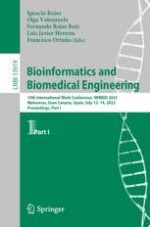2023 | OriginalPaper | Buchkapitel
Computational Study of Conformational Changes in Intrinsically Disordered Regions During Protein-Protein Complex Formation
verfasst von : Madhabendra Mohon Kar, Prachi Bhargava, Amita Barik
Erschienen in: Bioinformatics and Biomedical Engineering
Verlag: Springer Nature Switzerland
Aktivieren Sie unsere intelligente Suche, um passende Fachinhalte oder Patente zu finden.
Wählen Sie Textabschnitte aus um mit Künstlicher Intelligenz passenden Patente zu finden. powered by
Markieren Sie Textabschnitte, um KI-gestützt weitere passende Inhalte zu finden. powered by
